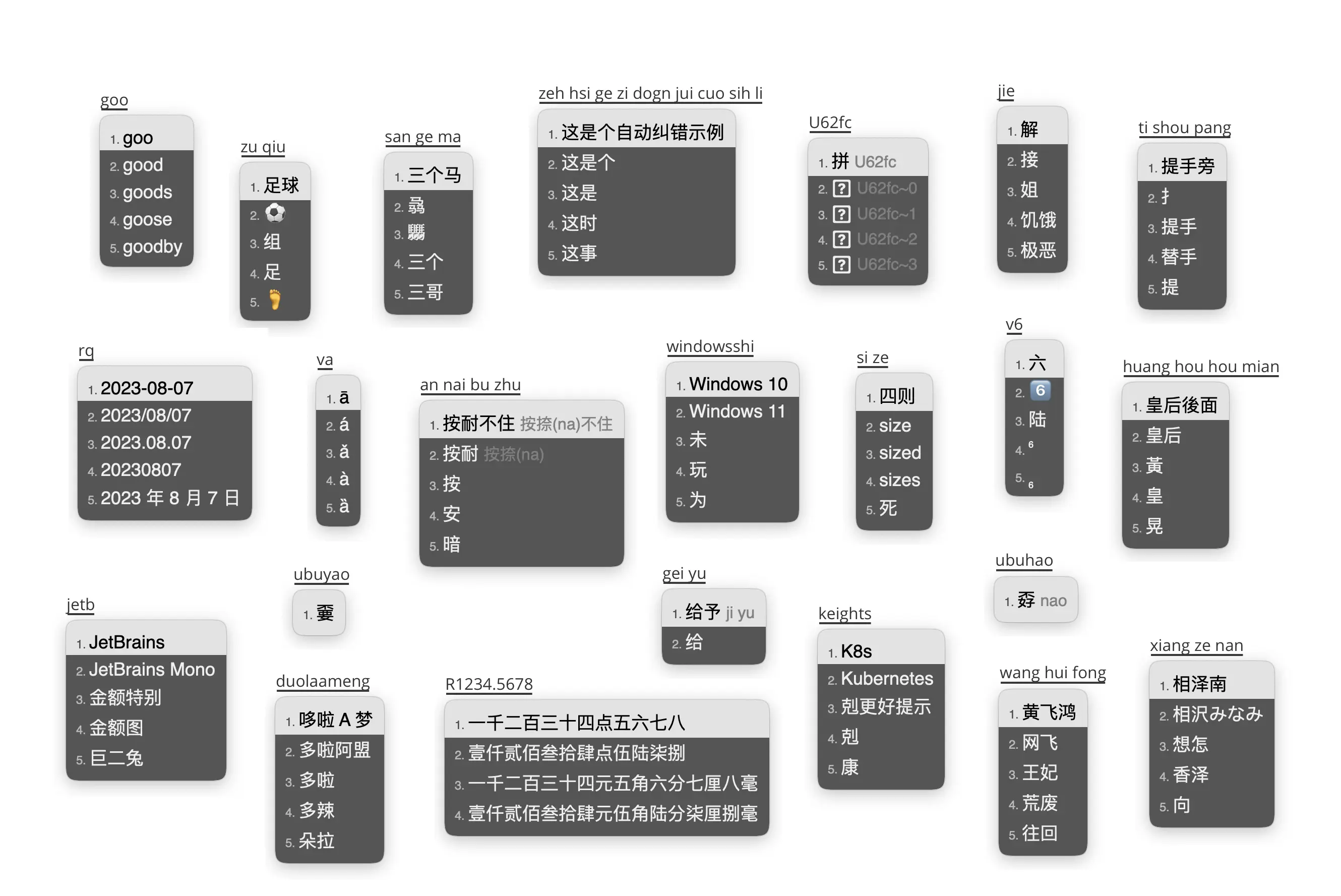Differences between rime-ice and oh-my-rime
Rime-ice: https://github.com/iDvel/rime-ice is a very good Rime input scheme, supporting multiple input methods such as full spelling and double spelling, and has a comprehensive vocabulary. At the same time, the repository is actively contributed. The vocabulary includes:
- Simplified character table, vocabulary
- General Standard Chinese Character Table
- Huayu Wild Wind System Vocabulary (@Wild Wind)
- Tsinghua University Open Source Vocabulary (@THUNLP | MIT)
- Modern Chinese Common Word List (@Joseph Cheng)
- Tencent Word Vector (@Tencent AI Lab | CC BY 3.0)
- References
- Modern Chinese Dictionary
- Synonym Forest
- New Chinese Idiom Dictionary
- Vocabulary revision
- Proofread a large number of variant characters, typos, and incorrect pronunciations
- Complete pronunciation of the entire vocabulary
- Pronunciation of synonymous polyphones

And based on the above vocabulary, build the main maintenance vocabulary:
8105character table.basebasic vocabulary.extextended vocabulary, small vocabulary.tencentextended vocabulary, large vocabulary.- Emoji
Next, let's talk about the differences between rime-ice and oh-my-rime.
Similarities
In basic aspects, they are all adapted to the Rime input method framework, supporting various input methods such as full pinyin and double pinyin, with comprehensive pinyin dictionaries.
oh-my-rime once directly used the rime-ice dictionary:
- oh-my-rime switched from self-maintained dictionary to rime-ice. As of 2024.07
- oh-my-rime used the rime-frost dictionary (based on rime-ice and retrained using Python's jieba for word segmentation). As of 2025.07
- oh-my-rime adopted the RIME-LMDG dictionary, with some Lua code also using open-source implementations, overlapping with rime-ice, rime-frost, and RIME-LMDG. Now
rime-ice and oh-my-rime both use some tools and schemes from other repositories:
- melt_eng English input (@tumuyan | Apache 2.0)
- Component decomposition scheme Reverse lookup, auxiliary code (@mirtlecn | CC BY-SA 4.0)
- Word-based character selection (@BlindingDark | LGPL 3.0)
- Numbers, RMB capitalization (@98wubi)
At the same time, oh-my-rime uses rime-ice's
- Common mispronunciation and typo prompts: corrector_filter.lua
- Automatic capitalization of English vocabulary: autocap_filter.lua
- And so on some detail similarities~
Of course, oh-my-rime also uses some tools provided by wanxiang, such as:
Therefore, in terms of usage experience, the pinyin input among rime-ice, oh-my-rime and wanxiang is quite similar.
Differences
There are also quite a few differences, after all, oh-my-rime was initially just my personal scheme, and many things also reflect my personal style.
Mainly reflected in:
- oh-my-rime adapts to more input schemes, such as 98 Wubi, 86 Wubi, and Xiaohe Double Spelling, etc., and uses Xiaohe Sound and Shape as an auxiliary code for auxiliary input. While rime-ice is mainly pinyin input, and considering that pinyin and shape codes are two completely different systems, it does not consider introducing shape codes;
- The theme styles of oh-my-rime and rime-ice are different (but this actually doesn't matter);
- Some Lua scripts are different, oh-my-rime uses some of rime-ice's scripts, but also has its own scripts; at the same time, some of rime-ice's scripts, oh-my-rime does not have; at the same time, some Lua may have the same function, but use different code implementation:
- Week, date, time: rime-ice and oh-my-rime can both use
week,date,timeto call up the current time; but the implementation code is different; - rime-ice has Unicode input, oh-my-rime does not; mainly because, I think the use of Unicode is relatively small, so it is not included;
- oh-my-rime, in order to limit the input of the check-in content, used
codeLengthLimit_processor.luato limit the maximum retrieval length, rime-ice does not have; - rime-ice has used long word priority and other Lua scripts, oh-my-rime does not have; still considering whether to add;
- ……
- Week, date, time: rime-ice and oh-my-rime can both use
- rime-ice's symbol customization and oh-my-rime's are not the same. For example, the input of some special characters, the two are completely different;
- The shortcuts of rime-ice and oh-my-rime are also different, and you need to mainly check the source code of each during use;
- rime-ice, in order to ensure compatibility, uses the old version of Lua syntax introduction, but oh-my-rime considers that the new version of Lua syntax is more concise, and the higher version of librime will always popularize various clients, so it uses the new version of Lua syntax introduction;
- rime-ice GitHub repository is more active, with more experts answering questions in issues. oh-my-rime is primarily maintained and contributed by @Mintimate and @YummyCocoa, who also communicate with wanxiang's author @amzxyz on QQ. Occasionally @mirtlecn, one of rime-ice's maintainers, might push some updates. Therefore, if you have questions, responses may take much longer. We recommend checking rime-ice's issues first to see if your question has already been answered.- And so on some small detail differences~
So, the difference between rime-ice and oh-my-rime is mainly in the adapted input scheme, Lua script, shortcut, symbol customization, GitHub repository activity, etc.
Suggestions for Choice
If you are a pinyin input user, then rime-ice is a very good choice; if you are a user who needs multiple input schemes, then oh-my-rime is a good choice.
It is only recommended to choose one scheme, do not use both rime-ice and oh-my-rime at the same time: because the configuration files of the two schemes will conflict, and the shortcuts of the two schemes are also different, which may cause input conflicts.
To give a practical scenario, if you use pinyin, then in fact both oh-my-rime and rime-ice can be used, and you can also make changes based on rime-ice and oh-my-rime (after all: oh-my-rime has a lot of references to rime-ice, and the open source protocol has also been synchronized from the initial GPL2.0, using the GPL3.0 protocol). However, if you also have a need for Wubi, such as other people in your family using Wubi, or other people using your computer using Wubi, then oh-my-rime may be a better choice.
Of course, this is just a suggestion, and it depends on individual needs. Moreover, the open source community environment of rime-ice in English is more prosperous, with more open source contributors, and the updates of rime-ice will be of higher quality than oh-my-rime (even I have submitted some PRs to rime-ice...).
The translation of the selected content is as follows:
Tips
In addition, don't think that the scheme is only rime-ice and oh-my-rime, there are many other schemes, you can choose according to your own needs. And, the authors of the scheme also communicate, for example: the main maintainer of rime-ice @iDvel's blog, is also a friend chain of my blog; the author of the rime-wubi86-jidian scheme @KyleBing authorized Mint to use his scheme and so on.
Everyone is working hard to contribute to the community, and I hope everyone can find a suitable input scheme.
Haha, also an advertisement, if you think this document or Oh-my-rime is very helpful to you...
For users who donate coffee☕️, they will enter the "Thanks" and "Log Update" (●'◡'●)ノ♥
END
Actually, I initially wanted to configure my own scheme, which led to the oh-my-rime configuration, borrowing a lot from the rime-ice configuration and inheriting the rime-ice configuration using the GPL 3 open-source license. Subsequently, practical and useful features have been continuously added to oh-my-rime.
However, the RIME community is a little small, and most of the features that can be thought of or discovered are already present in rime-ice (which is also one of the reasons why rime-shuangpin-fuzhuma is similar to rime-ice). Even though the Pinyin dictionary was later migrated from rime-ice to rime-frost, and to adapt to the Wubi98 team’s RimeTool, the experience is still similar to rime-ice.
Personally, I do not like reinventing the wheel repeatedly, but the current situation is that oh-my-rime, rime-ice, ime-frost, and rime-shuangpin-fuzhuma schemes have a lot of overlap and use the same dependencies. I am not sure if this is a good phenomenon, but if you want a scheme that suits you, for now, you can choose any one of them.
